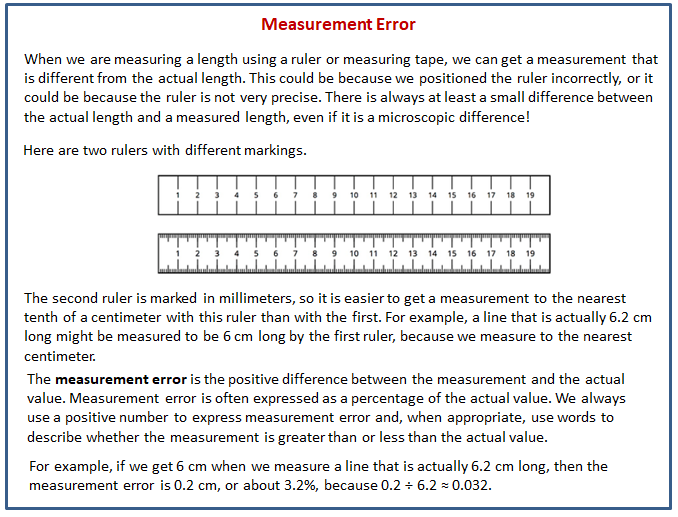Illustrative Mathematics Grade 7, Unit 4, Lesson 13: Measurement Error
Learning Targets:
- I can represent measurement error as a percentage of the correct measurement.
- I understand that all measurements include some error.
Related Pages
Illustrative Math
Grade 7
Lesson 13: Measurement Error
Let’s use percentages to describe how accurately we can measure.
Illustrative Math Unit 7.4, Lesson 13 (printable worksheets)
Lesson 13 Summary
The following diagram shows that all measurements include some error and how to represent measurement error as a percentage of the correct measurement.

Lesson 13.1 Measuring to the Nearest
Your teacher will give you two rulers and three line segments labeled A, B, and C.
- Use the centimeter ruler to measure each line segment to the nearest centimeter. Record these lengths in the first column of the table.
- Use the millimeter ruler to measure each line segment to the nearest tenth of a centimeter. Record these lengths in the second column of the table.
Lesson 13.2 Measuring a Soccer Field
A soccer field is 120 yards long. Han measures the length of the field using a 30-foot-long tape measure and gets a measurement of 358 feet, 10 inches.
- What is the amount of the error?
- Express the error as a percentage of the actual length of the field.
Lesson 13.3 Measuring Your Classroom
Your teacher will tell you which three items to measure. Keep using the paper rulers from the earlier activity.
- Between you and your partner, decide who will use which ruler.
- Measure the three items assigned by your teacher and record your measurements in the first column of the appropriate table.
- After you finish measuring the items, share your data with your partner. Next, ask your teacher for the actual lengths.
- Calculate the difference between your measurements and the actual lengths in both tables.
- For each difference, what percentage of the actual length is this amount? Record your answers in the last column of the tables.
Are you ready for more?
Before there were standard units of measurement, people often measured things using their hands or feet.
- Measure the length of your foot to the nearest centimeter with your shoe on.
- How many foot-lengths long is your classroom? Try to determine this as precisely as possible by carefully placing your heel next to your toe as you pace off the room.
- Use this information to estimate the length of your classroom in centimeters.
- Use a tape measure to measure the length of your classroom. What is the difference between the two measurements? Which one do you think is more accurate?
Lesson 13 Practice Problems
- The depth of a lake is 15.8 m.
a. Jada accurately measured the depth of the lake to the nearest meter. What measurement did Jada get?
b. By how many meters does the measured depth differ from the actual depth?
c. Express the measurement error as a percentage of the actual depth. - A watermelon weighs 8,475 grams. A scale measured the weight with an error of 12% under the actual weight. What was the measured weight?
- Noah’s oven thermometer gives a reading that is 2% greater than the actual temperature.
a. If the actual temperature is 325°F, what will the thermometer reading be?
b. If the thermometer reading is 76°F, what is the actual temperature? - At the beginning of the month, there were 80 ounces of peanut butter in the pantry. Now, there is 1/3 less than that. How many ounces of peanut butter are in the pantry now?
- a. Fill in the table for side length and area of different squares.
b. Is the relationship between the side length of a square and the area of a square proportional?
The Open Up Resources math curriculum is free to download from the Open Up Resources website and is also available from Illustrative Mathematics.
Try out our new and fun Fraction Concoction Game.
Add and subtract fractions to make exciting fraction concoctions following a recipe. There are four levels of difficulty: Easy, medium, hard and insane. Practice the basics of fraction addition and subtraction or challenge yourself with the insane level.

We welcome your feedback, comments and questions about this site or page. Please submit your feedback or enquiries via our Feedback page.